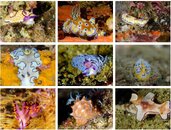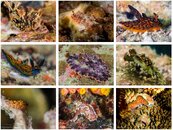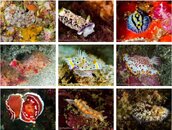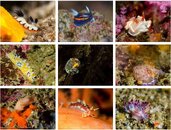Welcome to the vibrant world of nudibranchs...
For me nudi-hunting is like collecting stamps...
You always want to find new ones for your private collection.
I remember the first time someone pointed out a nudibranch to me during a dive, gesturing towards a rock and signalling “Look, something small”. What felt like minutes went by as I squinted and shifted focus trying to figure out what exactly I was trying to look at. Then suddenly a tiny piece of what appeared to be algae moved and I noticed it was actually alive! It couldn’t have been longer than a centimetre or so and was pink with beautiful blue and yellow tentacles sticking out all over its worm-like body and head. What WAS that thing? And how in the world had the dive guide seen something so minuscule and hidden?
What exactly is a nudibranch?
Today there are somewhere around 3000 documented species of these incredible molluscs that can range from a mere 4mm to a hefty 60cm. Nudibranchs are invertebrates that spend a certain stage of development with a shell. They will always shed this shell at some point before adulthood. All nudibranchs are members of the sea-slug family, however not all sea-slugs are nudibranchs. These “sea slugs” are hermaphroditic which means that each individual has both female and male reproductive organs on the right side of their body. They can lay up to 25,000 eggs at a time in a mucous ribbon-like formation that will take roughly a week to hatch.
Because they have both male and female sexual organs, a pair can inseminate each others so that you have two pregnancies instead of one. However nudis still need to find a mate. They cannot impregnate themselves!
Nudibranchs are carnivorous and love to eat sponge, hydroids, algae, coral, anemones and even other nudibranchs. They can be found mostly in shallow reefs in warm salt water, but there are some species that live in deeper or cold waters and some can even survive the lower salinity of brackish water. They are found in great abundance at any of the dive sites of the Mergui Archipelago in Burma.
What is so special about nudibranchs?
Apart from their gorgeous colouring and their many shapes and sizes nudibranchs have some special tricks up their sleeves that really sets them apart. Although they are small, they have developed some very industrious techniques to protect themselves. Many nudibranchs display bright colours for a multitude of reasons. Some practice what’s called aposematism which is colouration to suggest to predators that they aren’t tasty or can be toxic. This is a technique used by the Phylidiidae family that we often see in the Indo-Pacific. Some nudibranchs that feed on the stinging cells of jellyfish or hydroids can actually recycle them and use them as weapons. Glaucus atlanticus or the Blue dragon nudi can be found floating near the surface and feeds on the nematocysts of the Portuguese man of war Jellyfish and similar species. It will eat the stinging cells and pass them harmlessly through their body where they can then be displayed on their skin or in appendages called cerata making them harmful to predators.
Some nudibranchs that eat sponge will also use the same chemicals that their prey use to defend themselves to make them taste foul to their own predators.
Some can also make their own chemicals (regardless of what they eat or where they live) to serve similar purposes or can even secrete an acidic mucous when disturbed. Some nudibranchs will feed on plant cells and use them to create their own food sources. A particular group of sacoglossan sea slugs will eat certain algae found in soft corals and recycle their chloroplasts so they can create their own nutrients through
photosynthesis. This means that once it has eaten enough it doesn't need to eat any longer. The algae in its body will use the sunlight to create enough nutrient for its host to survive.
How do you identify a nudibranch?
Nudibranchs have complicated names which can be very daunting to someone just starting to learn about them. They often have common names which can be easier to remember but they can also cause confusion. For example, some people call the same nudi different names depending on where they dive and what the locals refer to them as. Sometimes a distinguishing feature that led people to give it a common name is not specific to that species leading different nudis to be called the same thing.
Using their scientific names is the best way to accurately identify nudibranchs even if it can be a bit of a mouthful. Taxonomy is the way we classify living things in biology and it is an intricate science. Basically speaking, plants and animals are divided into family trees that get more specific as you travel downwards eventually allowing you to name individuals.
Understanding the difference between the different species is a great place to start but there are other things to consider when identifying a special slug you found on the reef. Looking at its body shape can be very helpful as well as colouration and any markings like stripes or polka dots. Also when in doubt there are many resources available to you like marine species identification books or public forums on social media.
Some of my favourites are ID Please (Marine Creature Identification) and Nudibranch Central on Facebook.
What kind of nudibranchs can we find in the Mergui Archipelago?
The marine life in the Mergui Archipelago is so diverse that it has something to offer to any diver. Macro lovers rejoice in Burma and especially those with an affinity for nudibranchs. Behold some of the mesmerizing little beauties that we have found on our cruises.



 READ THE FULL ARTICLE ON OUR BLOG
READ THE FULL ARTICLE ON OUR BLOG




